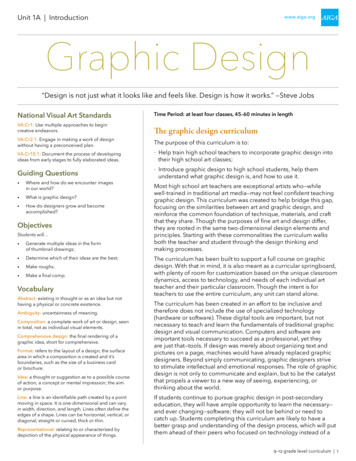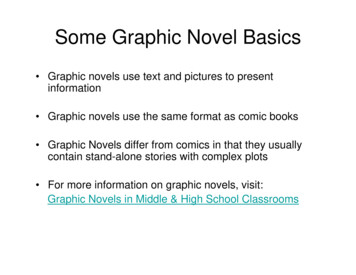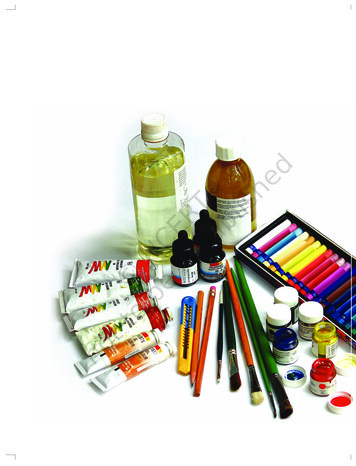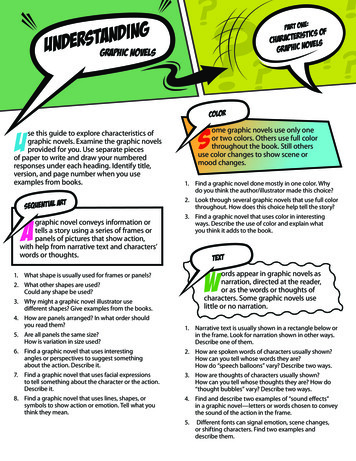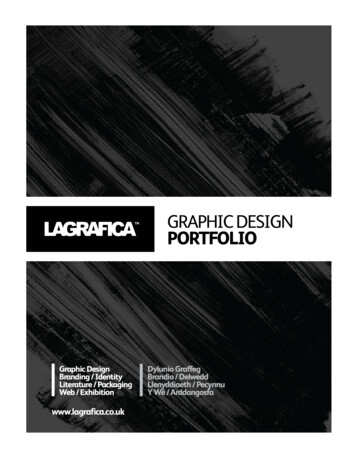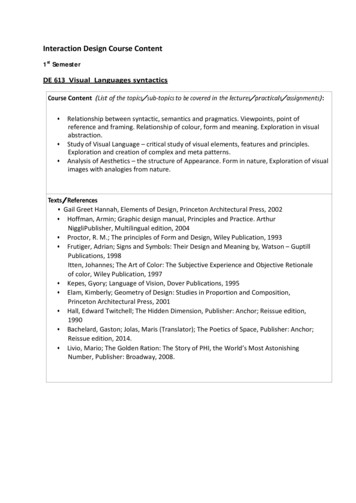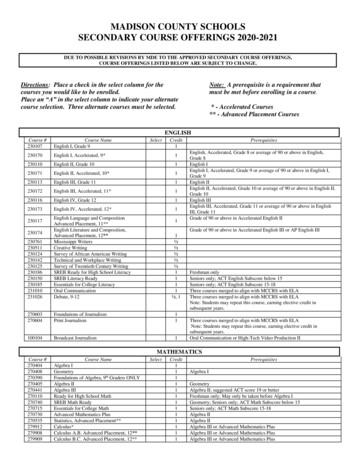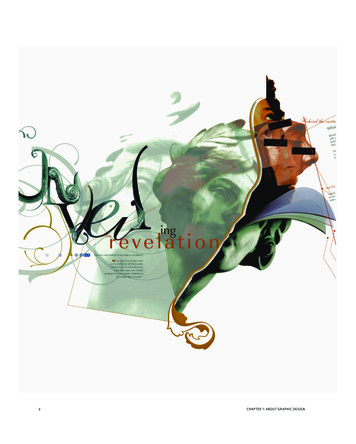
Transcription
2 CH01 G2GD Santoro final rev.indd 2CHAP TER 1: ABOUT GR APHIC DESIGN10/29/12 9:01 PM
CHAPTER OBJECTIVESAF TE R R E ADING THIS CHAP TE R , YOU SHOULD BE ABLE TO: Sequence the heritage of graphic design, beginningwith early cave paintings, noting the first use of the term,and continuing through to present times.About Graphic Design Summarize the many categories of graphic design. Describe what it means to be a graphic designer. Distinguish art forms and theories that have influencedthe development of graphic design. Sequence the steps of the design process, from the firstcontact with a client to the finished work. Characterize the basic components of a graphicdesign solution.1 Exercises and ProjectsResearch categories of graphic design; critique graphic designs;design a T-shirt using text and image; visually document andpresent a business through the eyes of a graphic designer.G raphic design is so much a part of our lives that at times it goesunnoticed. The layout of type and imagery on the page you’re reading rightnow is a key aspect of graphic design. This book was designed by organizingall the visual and textual information into a communicable message, anobject bound between two covers. But if organizing were the only job ofgraphic designers, the computer would have replaced us by now.I think design in essence has tohave an authentic honestybuilt into it. The main goal isto convey something that makesa difference in other people’slives. —Scott W. SantoroWatch the Video on myartslab.comOpposite page: Kareem Collie.Opening page (detail) forMan behind the Curtain (fullimage, see Figure 1.31). CH01 G2GD Santoro final rev.indd 3The field uses the two words graphic and design because of the dual natureof its process. Successful design solutions stimulate viewers intellectuallyand move them emotionally by including both familiar and surprisingelements. As a result, a design communication can not only explain something to an audience but also affect that group on another level.If you apply this complex thinking to your design process, theresults will reflect your intentions, and your messages will be clear. Awebsite is user friendly when its pages are attractive and its navigationsimple; a book’s content might be more accessible when its cover presentsan expressive visual metaphor; a building is easier to navigate when thearchitect has applied a logical system of signage to its passageways. Eachof these situations presents a unique communication problem, solvedwith specific design approaches.Being a designer also involves finding ways to reveal the beautyin something that others may not see and expressing a thought in an310/29/12 9:01 PM
1.1 Rafael Esquer. Clothingdonation bag sent to clientsfor the holidays as a way tohelp people in need.4 CH01 G2GD Santoro final rev.indd 4unexpected way—a mission through which blending the useful withthe aesthetically appealing has one primary goal—to communicate. Forexample, Rafael Esquer embraced the notion of giving instead of receivingby transforming a clothing collection bag into a typographic call to action(Figure 1.1). The fresh approach was also a declaration that read visuallyas “This idea is so clever, I want to help.” According to the designer, mostpeople liked the design so much that they kept it as a laundry bag and senttheir clothing donations in plain bags and boxes.In another example, Pierre Bernard transformed the scaffoldingfor an architectural renovation into a sidewalk spectacle for the CentrePompidou in Paris (Figure 1.2). A giant program listed the museum’smonthly events, and, after each event was over, it was manually crossedout by mountaineers hoisting themselves down on ropes. This creativeidea made a simple calendar into a continually dramatic and entertaining performance. The designer found an idea and pushed it further thananyone would have expected. A graphic designer needs to be part artist,scientist, researcher, psychologist, and businessperson.Design work incorporates aesthetics (to achieve notions of beauty)structure (to organize and arrange), emotion (to accentuate feelings), andCHAP TER 1: ABOUT GR APHIC DESIGN10/29/12 9:01 PM
View a Closer Look for the Centre Pompidou on myartslab.com1.2Pierre Bernard, Atelier deCréation Graphique. For theCentre Pompidou renovationin Paris, a temporary systemof signs was devised. Type washoisted up, crossed out, andultimately removed. Everything is design. Everything!—Paul Rand CH01 G2GD Santoro final rev.indd 5utility (for use). Whether designing for an individual, a small business, ora large corporation, the designer brings a degree of art, craft, intelligence,and intuition to every project.Graphic designers often collaborate with writers, illustrators, photographers, and printers, making for an energizing work environment.Clients sometimes invest large sums of money, and an audience of millions just might see the designer’s work, but the most exciting aspect ofthe graphic designer’s job—and the most admirable one—is saying something that matters, and saying it with both grace and intelligence.510/29/12 9:01 PM
Graphic Design’s Heritage1.3 Lascaux cave paintings,Dordogne, France.Graphic design (the art of conveying messages) has always been a partof us, even as far back as the early cave paintings of approximately 16,000years ago. Scenes of the hunt—like the ones pictured at Lascaux—mayhave been more than merely decorative, possibly serving a number ofpurposes (Figure 1.3). One purpose may have been to literally describethe animals as an instruction manual might, picturing what to chase andwhat to avoid. Another likely purpose may have been to bring good fortune by symbolically capturing the animals on the wall. Made with onlyburnt sticks and colored pigments, these beautifully executed designscould have motivated the hunting group and helped it to survive.Fast-forwarding 14,000 years, a stone mosaic from Pompeii wasused to communicate an important message: “Beware of the dog” (Figure1.4). A ferocious dog perfectly translated into the black and white mosaicalong with words of caution made its point clearly to visitors. Forwardanother 1,700 years to America’s first political cartoon, Join or Die, awoodcut by Benjamin Franklin (1706–1790) (Figure 1.5). Franklin’s witand conviction can be seen in the design of a snake severed into eighths,each segment representing a British American colony or region. Thedesign inspired colonial unity in a yet-to-be-born country.Today, digital printing and electronic media have replaced cave wallpaintings, mosaics, and woodcuts. But the functional aspect of graphicdesign is the same—to educate, symbolize, and even compel us to action.Understanding graphic design in the context of its history is essential to being a good designer. In Chapter 2, A Brief History of GraphicDesign, you will come to see why this context is so important.The Coining of the Term1.4 Cave canem (beware ofthe dog) mosaic, Pompeii, Italy.Late first century AD.1.5 Benjamin Franklin’s political cartoonthat appeared in the PennsylvaniaGazette, his American newspaper from1754. In Franklin’s time, a superstitionexisted that a snake cut to pieces couldbe brought back to life if the pieces wereput back together before sunset.6 CH01 G2GD Santoro final rev.indd 6The great book designer W. A. Dwiggins (1880–1956) coined the term“graphic design” in 1922. Since then, graphic design has grown intoits own, legitimate profession. Dwiggins had it right in two ways. Firstby blending the words graphic and design, he better explained the process—graphic sensibility fused with planning and organizing. Second, bynaming the profession, he categorized it as its own, legitimate activity.Although graphic design had an association with commerce, just asprinting, lettering, and the advertising trades did, it was no longer considered a subcategory of those trades but a valid field in its own right.Dwiggins’s term was just abstract enough to encompass many kinds ofdesign. (See the upcoming Excerpt from “The Name Game,” by MichaelWorthington.) The categories of graphic design, as described in this chapter, all have their own particular practices, and what unites them is theprocess graphic designers go through to communicate a concept.As you continue reading this book, you will see just how that concept of process applies to the art of graphic design. The field is as muchCHAP TER 1: ABOUT GR APHIC DESIGN10/29/12 9:01 PM
about problem solving, clear thinking, and creativity as it is about the endresult, the final design.Graphics Design1.6 The s in graphics waseventually dropped by themedia at the insistence ofthe profession.In Practice: Oddly enough, it wasn’t until the late 1970s thatthe media began to refer to the profession as “graphic design.”Until then it was mistakenly called “graphics design,” describingonly the end product (the design of graphics), and neglectingthe idea that there was an approach to the process, which the termgraphic design more accurately describes. The media droppedthe “s” (Figure 1.6).The Expanding Field of DesignOne of the wonderful things about the graphic design field is that itencourages creative people to develop personally challenging goals. Pushing further, beyond the most obvious design solution, is integral to beinga good designer. This effort includes pushing how we develop concepts,how computer technology enables us to complete our tasks, and how newmedia can help expand graphic design language itself.And we have academic support. In the last few decades, an increasing number of students have been pursuing master’s degrees in graphicdesign and contributing to the rich mixture of ideas and culture. As aresult, the field has grown and become a more sophisticated, serious fieldof study. Even a doctoral degree, the highest degree awarded in most disciplines, is now attainable as a course of study in graphic design, advancing research and enriching scholarship within the field. Books, journals,and magazines on the subject of design flourish, acknowledging the field’shistory, theory, methods, and influence. Graphic designers work in countless industries and throughout the world. And yet, design is still a bit ofa subculture. Its professionals need to be constantly self-critical to ensurethat the field expands beyond the mere styling of information. Graphicdesign reflects and shapes the culture in which it exists. E xcerpt: The Name Game by Michael Worthington(AIGA Journal, Vol. 16, No. 2, p. 37)Eventually I realized it is the vagueness of the term “graphic design” that makes it soappropriate. The same reason my grandmother initially couldn’t understand that term is thevery reason it works. It can cover myriad skills, cope with technological innovationsand changes in the profession, but still refer to the larger concerns of visual communication,representation, and issues of creating meaning through content. This flexibility allows meto take on the role of an interface designer, website designer, or motion typographer, and addthat knowledge to the variety of skills that currently fall under the title “graphic designer,”a term that itself is as unfinished and malleable as any digital piece of work.graphic design’s heritage CH01 G2GD Santoro final rev.indd 7710/29/12 9:01 PM
Graphic Design CategoriesTo varying degrees, the intent of design is to persuade, identify, or inform.A book jacket informs the viewer of the book’s content, persuades thereader to buy, and identifies the writer. The same is true in food packaging where persuasion, identity on the shelf, and information all matter.Even a geographical map’s organization and clarity requires the designerto decide on what to include and exclude as well as how to present theinformation. A clear map is more likely to be purchased and used than aconfusing map.A designer’s clients can range from a small, nonprofit organization in need of a few hundred educational posters (Figure 1.7) to a majorcorporation requiring a set of streamlined, easy-to-read forms that areprinted in the millions (Figure 1.8). Take the time to get to know yourclients as well as you can. It can help tremendously in producing a designthat fits their needs. Each of the specialized areas of graphic design hasits own particular problems to solve. The job of a publication design isnot the same as that of a package design, for example. But with eachproject, it is you, the designer, who will bring a graphic sensibility to thefinal product.Corporate DesignCorporations have large, internal design departments, hire independentdesign consultants, and devote relatively large amounts of money for theirgraphic design projects. Corporations need to project a consistent visualidentity—one that brands a corporation into the minds (and hearts) ofthe general public.1.7 David Plunkert, Spur Design.Posters for TurnAround, a nonprofitagency serving victims of sexualassault and domestic violence.1.8 Landor Associates.FedEx Express airbill.FedEx servicemark used by permission.8 CH01 G2GD Santoro final rev.indd 8CHAP TER 1: ABOUT GR APHIC DESIGN10/29/12 9:01 PM
Environmental DesignCreating a three-dimensional experience for the visitoris the goal of an environmental designer (Figure 1.9).The category includes the design of museum exhibits,trade shows, and convention booths. Environmentaldesign overlaps with signage design in the sense thatboth types of designers work closely with architects aswell as interior and landscape designers and must havean understanding of structural materials. In addition,environmental designers must know audio/visual media,including lighting and sound techniques, and interaction design. Environmental design usually includes thedisplay of signs, information designs, and other types ofpromotional materials. The overall design must remainin keeping with the objects or designs it contains.Motion Design1.9 Kuhlmann Leavitt, Inc.Design for Formica Group Neoconexhibition space.This evolving field of design involves adding sound,motion, and time sequencing to pictures and words.Filmmaking, animation, and visual effects converge totell a story or visually articulate a concept. Motion designprojects include film title sequences, trailers, animations,and broadcast identifications (a short spot that confirmsthe channel being watched). The finished projects aredisplayed on television, in the cinema, on computerscreens, and even through cell phones (Figure 1.10). (Seethe Speakout by Barry Deck on page 10.)1.10 Number 17, NYC; Emily Oberman,art direction; Naz Sahin andJessica Zadnik , design; Mary EllenMatthews, live action. Openingtitles for Saturday Night Live.graphic design categories CH01 G2GD Santoro final rev.indd 9910/29/12 9:01 PM
Interaction DesignDesigners involved in this computer-based medium create user experiences through Internet browsers and touch-screen devices. Softwareallows for interaction through body movement and speech. This fieldis a quickly evolving one, and designers need to stay current with thelatest software and hardware advancements. The field requires a workingknowledge of programming languages (Figure 1.11).Type Design1.11 Mode. Website design forMellow Mushroom restaurant.A type designer creates new letterforms and fonts (variations such as italicand bold) to develop a complete typeface family. The elements include letters, numerals, ligatures (where two letters are joined), and punctuation.The designer must have a sharp sensitivity to detail to create a unifiedfeeling within a typeface. It is important to have a strong knowledge of thehistory of type and an understanding of the theoretical issues involved.As with all design fields, good skills in the latest computer technologywill simplify your task. Type design involves a great deal of effort and theresults may not be obvious to the general public, but designers understand how expressive a typeface can be and how it can subtly influencethose who read it (Figure 1.12).1.12 Jonathan Hoefler.Hoefler & Frere-Jones coverfor specimens of type,8th edition. SpeakOut: Motion Design’s Evolving Role by Barry Deck, BarryDeckGroup Although the practice of graphic design began with print, designers are being asked with increasing frequency to consider time, motion, and sound in their work. This is part of a general trend incommunication, which may have started with cave paintings and could lead to the making of fullon virtual reality experiences. Most of the messages that were conveyed in print only a century agohave now shifted to onscreen media, like movies, television, software, games, and the Internet. In ElLissitzky’s 1923 manifesto, Topography of Typography, (which appeared in Kurt Schwitters’s Dadaistmagazine Merz), he wrote exuberantly, “The printed sheet overcomes space and time. The printedsheet, the infinity of the book, has to be overcome. THE ELECTRO-LIBRARY.” That future is here,and technology continues to evolve. As the possibilities of the technology change, the designer’srole begins to overlap with other disciplines. The difference between design and art has always beena subject of debate. Boundaries between graphic design and writing, software design, behavioralscience, film directing, and editing do indeed blur. The graphic designers of the future will havemore responsibilities and collaborators than ever, but there will always be a role for people skilledin telling stories visually.10 CH01 G2GD Santoro final rev.indd 10CHAP TER 1: ABOUT GR APHIC DESIGN10/29/12 9:01 PM
Publication Design1.13 Andrea Fella. Paper magazine.Layout spread for this New YorkCity-based independent magazinefocusing on fashion, pop-culture,nightlife, music, art, and film.Magazines, newspapers, newsletters, and other periodicals all fall within the umbrella of publicationdesign. Thousands of periodicals are published eachyear in the United States alone, and other countries areequally invested in their own periodicals. Categoriesinclude news, business, travel, retail, entertainment,and fashion, and these publications are distributedweekly, monthly, quarterly, or annually. Each periodical strives for a unique identity, and the elementsthat provide this uniqueness are a blend of photography, typography, and continuity from page to page.In terms of design, a newspaper or newsletter mightstress utility of reading, whereas a magazine will stress creative interpretation of each story (Figure 1.13). Now that most publications have both aprint and online presence, designers have to consider how their designswill function in both platforms. A particular printed font may not workwell online, or a sequence of images in print may not present themselvesin the same way on the screen. Do you design for print and adapt it for theWeb or vice versa? Or do you design with both formats in mind from thebeginning? These decisions challenge publication designers every day. Asonline technology advances, such design decisions become not only morecomplex but also more important for the publication.Book DesignBook publishers give the final, edited text to designers for layout. It isimportant that the designer understand the content when making decisions about the font, headers, and all other design elements. The styledecisions need to be consistent with the subject matter (Figure 1.14).Illustrated books present a whole different set of design challenges.1.14 Mucca Design. Layoutspread for a dictionary of wordsthat are a single letter in length.Initial letters were also designedspecifically for the book, herea large letter M.graphic design categories CH01 G2GD Santoro final rev.indd 111110/29/12 9:02 PM
Book Jacket DesignThe success of a book, or a series of books, may be dependent on the coverdesign. The cover relays a great deal of nonverbal information about thecontent. The ultimate test is the bookshelf—either at actual book storesor on a website where a book becomes a miniposter. The designer’s job isto attract notice and provide a point of entry for the book (Figure 1.15).Signage DesignHelping people find their way through stores, airports, highways, andbuildings is the main goal of signage design. A strong understanding oftypography is essential in this area of design, as is an understanding ofbuilding plans, floor plans, construction, and exit procedures. Signagedesigners work with interior and landscape designers as well as architectsto create signage—a sign, or system of signs, that will be highly visible butalso will integrate with the space for which they are planned (Figure 1.16).1.15 Keenan . Book jacket for TheBug, Vintage Books. The image ofcomputer keys illustrates this novelabout the fate between a softwareprogrammer and the bug she setsout to eliminate. A book is a container to save thingspermanently; better than a pictureframe or filing cabinet.—Alvin Eisenman1.16 Michael Gericke/Pentagram.Signage and wayfinding forTerminal 1 at Lester B. PearsonInternational Airport, Toronto.12 CH01 G2GD Santoro final rev.indd 12CHAP TER 1: ABOUT GR APHIC DESIGN10/29/12 9:02 PM
1.17 Duffy & Partners. Logo for TallTales Restaurant. The hand craftedillustration brings warmth and charmto this Gander Mountain restaurant.Worksight. Pocket folder andcapability brochure for AutomaticData Processing (ADP). Computerizedtransaction processing is abstractedas a cover image for ADP’s pocketfolder. Inside, the brochure literallytranslates the end result of thecover—a mailed piece.1.18Brand and Identity DesignFor any company to succeed, it must establish its own, unique brand (anidentifying personality) that is burnt into the mind of its audience. A logo(a graphic or symbolic representation) can accomplish this function bypresenting a face for the viewer to see—a visual identity (Figure 1.17).A logo also differentiates one company from another, becoming quitevaluable if used consistently in advertising, print collateral, websites, andbroadcast media.Graphic designers who work at corporations create a wide arrayof materials. Style manuals help coordinate how a corporate identity isapplied to various communications from the annual report and websites,to business cards, advertising layouts, and environmental signage. Thegoal is to create a comfort zone for the general public by consistently presenting a familiar, instantly recognizable face (Figure 1.18).Package DesignPackage design must function three-dimensionally and often utilizes texture as well as text and image. Industrial packaging is a major field, but it’sthe consumer category that holds the most presence for industry, including food and beverages, cosmetics, household products, pharmaceuticals,and smaller groups. Decisions about size and shape are often impactedby government regulations, and decisions about the overall personalityand approach are often determined based on focus groups and consumerfeedback (Figure 1.19).1.19 Larsen. Photography Lars Hansen. Le Saucier packagedesign using contemporary typography and photographyto bring a distinctive look and feel to this product.graphic design categories CH01 G2GD Santoro final rev.indd 131310/29/12 9:02 PM
Information DesignThe presentation of information and data is both an art and a science.The designer must make data understandable and easy to use in a waythat is effective, efficient, and attractive. Typical examples might includeinstructions for product use, signs, public information systems, computerinterfaces, websites, forms, educational materials, maps, charts, graphs,and diagrams (Figure 1.20).Collateral DesignPromotion that supports or reinforces an identity, service, or event isconsidered collateral material. This type of material includes brochures,mailers, catalogs, announcements, and so on. These materials usuallyrequire copywriting (composing the words), photography, and illustration (stylized drawing/painting). While advertising agencies handlemajor campaigns for promoting a brand’s product or service, they willoften commission designers to produce collateral pieces (Figure 1.21).1.20 Nigel Holmes. A map ofManhattan/World Trade Centerfor Rolling Stone magazinethat helped readers locate thespecific 9/11 site known as“Ground Zero.”14 CH01 G2GD Santoro final rev.indd 141.21 Jason Ackley, Morningstar.Morningstar FundInvestor andStockInvestor newsletters thatproject a clarity and vibrancyto complicated financialinformation.CHAP TER 1: ABOUT GR APHIC DESIGN10/29/12 9:02 PM
Advertising Design The secret of all effective advertisingis not the creation of new and trickywords and pictures, but one ofputting familiar words and picturesinto new relationships.—Leo Burnett (1891–1971)Graphic designers working within advertising media fuse their understanding of visual identity with campaign marketing strategies. Magazineadvertising and direct mail are two potential directions for designers totake in this category. Designers can bring a graphic sensibility to traditional campaigns and help integrate type and image to strengthen advertising concepts. Advertising designers usually have a strong backgroundin marketing (Figure 1.22).1.22 Scott Stowell, Open.The “Between” campaign,developed in collaborationwith ad agency Wieden Kennedy advertising agency,tries to make Coca-Cola morea part of everyday Japaneselife. Each print ad defines amoment (and chance to drinkCoke) by what came beforeand what comes after. Inthis example, the theme was“between heartbreaks.”Self-PublishingA digitally interactive performance is an example of how newmedia and activities can be incorporated into a self-publishedproject. In the example shown here, the designer Elliot Earls combines elements of music, poetry, typography, design criticism, andperformance into a piece that enters territory traditionally definedas fine art (Figure 1.23).1.23 Eliot Earls. Video still.Eye Sling Shot incorporates amélange of typography, sound,video fragments, interactivedigital video, simulated liveperformance, short films,and pop music—all controlledby means of midi (musicalinstrument digital instrument).graphic design categories CH01 G2GD Santoro final rev.indd 151510/29/12 9:02 PM
Being a Graphic Designer1.24Travis Olson, CarmichaelLynch Thorburn. Logo designfor Poetry Slam, Inc.16 CH01 G2GD Santoro final rev.indd 16The field of graphic design is always changing and advancing. Keepingup with these changes means the life of a designer is continually exciting.The software applications used to create and assemble designs are makingproduction effortless, digital printing technology is advancing every day,and critical writing on design has gained respect as a legitimate field. Thegeneral public seems to be more aware of the design world and of the hugeimpact graphic design has on daily life.The design field can be so much more than a straightforward job.Designers are paid to be creative and expressive—something so fewpeople in other occupations can claim. But the field also offers the chanceto contribute to the community in a positive way. From social to politicalto environmental causes, each project offers an opportunity to make adifference in the world.Contributing to the community in which you live begins with anawareness of that community. A conscious observation of how information is presented and how meaning is read must become your path ofstudy. To be an informed designer, you need to be continually aware ofcurrent events as well as political, economic, and social issues. In otherwords, you need to take responsibility for your place in the world by reading newspapers, books, and magazines and by listening to the news. Youshould also keep up with what is happening in your community culturally—by going to museums, galleries, concerts, and theater. If you canpresent yourself to a client as a person who is intelligent and worldly, theclient will trust your judgment ever so much more than if you appear tobe uninformed. All this knowledge will help with your design work ona very practical level. The abilities we use to interpret culture and socialissues are the same ones we exercise to solve design problems.As a case in point, consider the Poetry Slam logo by Travis Olsonand Carmichael Lynch Thorburn (Figure 1.24). Here the designers havecreated a humorous character to convey the organization’s spirit; thestarburst inside the voice bubble evokes a sense of passion about poetryreadings. These events are not the tame readings you might have gone toin college. A poetry slam is a raucous, exciting, and creative affair. Thesimple colors of black and red further reflect the emotional charge ofslamming. When form and content blend as well as they do here (withbold and simple lines and shapes), they achieve an effective whole, givingthe design vitality through its consistency. The designers have been topoetry slams and know what they’re about. They use that knowledge tocreate meaningful designs.CHAP TER 1: ABOUT GR APHIC DESIGN10/29/12 9:02 PM
Voice and Vision1.25Stefan Sagmeister andHjalti Karlsson. “Move OurMoney” charts as part of atraveling road show.Acknowledging your individual point of view in yourown work also has significant value. The places you’vebeen, the things you’ve seen, felt, or heard, all feed intoyour ability to approach a design project in a uniqueway. Your life experiences, as well as your education,will have a profound impact on your designs. Because ofthese influences, your work will have a distinct identityand will be a contribution to the field and to the community. (See the Speakout by Kali Nikitas and Figure 1.27.)So many charts are a mundane representation ofdata, but the “Move Our Money” chart is anything butdull (Figure 1.25). The designers blended creativity withpolitics through an unusual medium—an inflatable balloon. Part of a traveling road show, the sculpture dramatized extreme military spending, creating a spectaclewherever it went. The designers’ voice and vision madean otherwise dull set of statistics b
design. (See the upcoming Excerpt from “The Name Game,” by Michael Worthington.) The categories of graphic design, as described in this chap - ter, all have their own particular practices, and what unites them is the process graphic designers go through to communicate a concept. As you continue reading th

